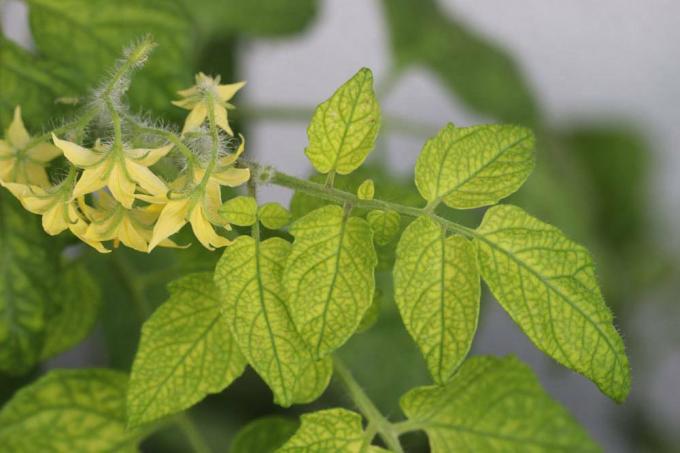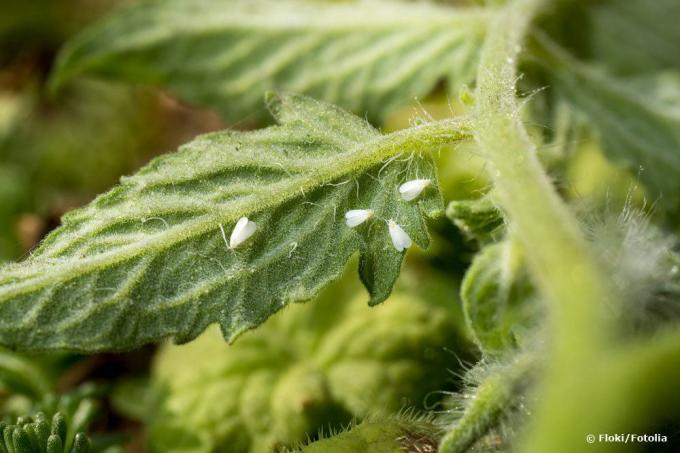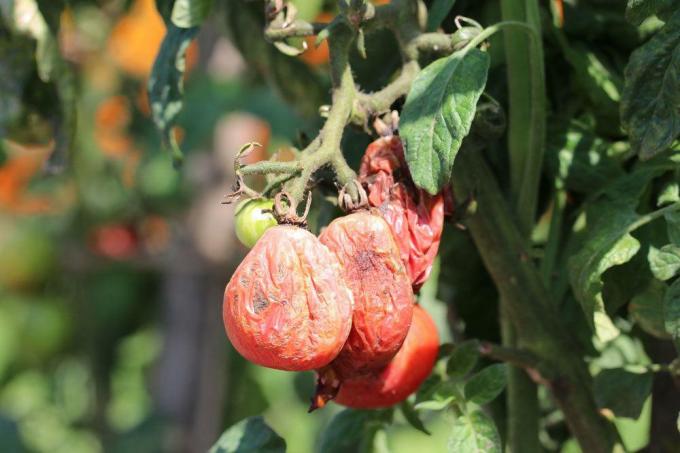
table of contents
- Yellow tomato leaves
- Care errors
- Treat young plants properly
- Correct lighting conditions
- Nutrient supply
- Proper water supply
- Diseases and pests
- Leaf spot disease
- Bacterial wilt
- Thrips
- Whiteflies
Tomatoes (Solanum lycopersicum) from your own garden taste particularly good. You don't need a lot of space and you can even get by on a balcony in the bucket. In addition to regular watering and weekly fertilization, there is not much to do, the tomato plants are easy to care for. Nevertheless, care errors, diseases or pests can occur, which for example cause yellow tomato leaves. Depending on the causes, the problem can be solved with simple solutions or with a little effort.
Yellow tomato leaves
Yellow tomato leaves are especially worrying when it is not a single patch or leaf, but rather when a large part of the plant is affected. In order to find out the cause and to be able to choose the right solutions, the plant must be carefully examined. The following questions should be answered:
- are only individual tomato leaves or tomato plants yellow or does it affect all of them?
- do the older leaves turn yellow or the young ones?
- does the entire tomato plant yellow?
- are other abnormalities recognizable?
Care errors
Although the cultivation of tomato plants is not very complicated, small, unnoticed mistakes can always occur. However, unlike diseases or pests, they are easier to fix. Care errors can be suspected above all if many or all of the plants are affected. As a rule, all tomato plants in the garden are cared for in the same way.
Possible are:
- incorrect treatment of young plants
- too little light
- incorrect fertilization
- too much or too little water
Treat young plants properly
Yellow tomato leaves after moving outdoors occur especially if the tomato plants have not been sufficiently hardened. If grown under glass or in the apartment, Solanum lycopersicum is not used to sunlight. If the young plants are put outside without hardening, the conversion leads to yellow leaves on the tomatoes.
More symptoms
- sagging leaves despite watering
- slow or no growth
- Burns on the leaves

remedy
In a specific case, one can only wait and try to provide the plants with optimal care so that they can recover. The yellow color of the tomato leaves will then disappear over time. Older leaves can also be shed. However, the new shoot is then healthy.
The next young plants are then hardened by gradually getting used to the sunlight. To do this, take them outside during the day as soon as it is sufficiently warm. In the first few days in the shade, later in the sun. At night or when it's too cold, the plants stay inside.
Correct lighting conditions
Tomatoes are one of those plants that are very hungry for light. They grow best in full sun, or alternatively in partial shade. If the plants get too little light, the tomato leaves can turn yellow.
More symptoms
- Geiltriebe (long shoots without leaves)
- New growth remains weak
- hardly any flowers
remedy
This is easiest with plants that grow in pots, they are simply placed in a place with more sunlight. Plants that grow outdoors may have to be replanted or more light can be guaranteed in some other way. Strong midday sun should be avoided.
Nutrient supply
Solanum lycopersicum is one of the Heavy consumers, only with regular and high nutrient addition can healthy, vigorous plants develop and produce rich yields. Depending on which nutrient is missing, different symptoms can occur on the tomato:
- Insufficient growth, yellow cotyledons, older leaves die, fruits remain small: lack of nitrogen
- older tomato leaves turn yellow from the inside, leaf veins and edges remain green: magnesium deficiency
- yellow edges and tips on the foliage, later brown, withered, leaves and plants that remain small: lack of potassium
- whole plant turns yellow, flowers rot: lack of calcium (cause of the flower end rot)
- yellow leaves with green veins: iron deficiency (possibly too much lime in the soil)
- yellowed leaf tips, rolled up, dying leaves: copper deficiency
- takes care of the plant despite fertilization: lack of lime

remedy
Tomatoes grow best in very nutritious soil. The ground should be prepared accordingly. Compost or manure can be brought in as early as autumn. Green manure is cut and dug under shortly before the tomatoes are planted. When planting, horn shavings and rock flour are put into the planting hole. This also applies to potted plants.
tip: If the bucket is big enough, a layer of manure can be added as the bottom layer. This is followed by some soil so that the roots of the young plants do not burn.
If the soil is well supplied, it is sufficient to fertilize the tomatoes every two weeks. If they are mulched all the time, fertilization can be even less frequent. Potted plants, on the other hand, are supplied with liquid fertilizer once a week or horn shavings are worked into the top layer of soil. Once a month you then mix rock flour into the substrate, this prevents a lack of lime.
tip: It can be worthwhile to have a soil sample from the garden examined for nutrient deficiencies.
Proper water supply
Tomatoes can have both too much and too little moisture. The symptoms are similar:
- limp plants, leaves hang down
- yellow tomato leaves, possibly brown when dry
- reduced new growth due to insufficient nutrient supply
remedy
If the substrate is too dry, you should water more frequently and more thoroughly. A layer of mulch also prevents too much water from evaporating. Sandy soil can store water better with the help of humus. It is more difficult if the plants are too wet. Waterlogging can cause the roots to rot. Potted plants are best repotted. In doing so, you should remove the damaged roots. You should also ensure good water drainage in the new bucket. If tomatoes are cared for outdoors, good drainage must be ensured when planting. If the location is still too wet, caring outdoor tomatoes are also transplanted. Loamy soil can be made more permeable with sand.
Diseases and pests
If the tomato plants are well cared for and care errors can be ruled out, you need to consider diseases and pests. This also applies if only individual tomato plants have yellow leaves. The main causes are:
- Leaf spot disease
- Bacterial wilt
- Thrips
- Whiteflies
Leaf spot disease
Tomatoes are susceptible to many fungal diseases. One of those that also causes yellowing foliage is leaf spot disease (Septoria lycopersici). Small, watery spots with a black border form before the leaves turn yellow. The infected leaves die off at some point, and the plant is weakened in the process. The fruits stay small but are edible. The disease cannot be treated in the home garden. However, infected leaves should be removed and ideally disposed of with household waste.
Prevention (for all fungal diseases)
- Keep plants above the ground dry
- Canopy protects against rain
- airy location and wide planting distances ensure enough air circulation
- Regularly prune the plant to prevent it from growing too densely
- Take particular care in humid and warm summers, check plants more often
- resistant resp. Use tolerant seeds
- frequently ventilate plants in the greenhouse
- remove the lower leaves on the stem

Bacterial wilt
The bacterialwekle (Corynebacterium michiganense) is characterized by yellow tomato leaves. Cut shoots show brown-yellow vessels. As the disease progresses, the leaves turn brown and fall off. The infection can also spread to the tomatoes, making them inedible. For prevention, you should follow the same advice as for leaf spot disease.
Treatment of diseased plants:
- Separate healthy from diseased plants
- remove and destroy affected leaves
- Remove mulch and loosen up soil
- Mix compacted soil with sand
- Reduce fertilization
- Tonics generally ensure healthy growth
Thrips
These tiny flies suck the sap from the leaves, they turn yellow. The larvae, on the other hand, attack the roots. In the open air, thrips (Thysanoptera) are usually not so common that treatment is necessary. They can do a lot of damage in the greenhouse. Fighting is easier there, however.
Treatment:
- Spray outdoors with soft soap solution (mix 1 liter of water with 15 ml of soft or curd soap)
- alternatively dust the tomatoes with rock flour
- Beneficial organisms (predatory mites, hover flies) can be used in the greenhouse
- Glue boards are also helpful
Whiteflies
The little white flies (Trialeurodes vaporariorum) damage a lot of vegetables. However, they can be particularly troublesome in the greenhouse. Like thrips, they too suck the sap from the plants. The leaves of the tomatoes will then turn yellow over time and the tomato will take care of it. Outside, a vegetable net protects against white fly infestation. If the tomatoes are in a tomato house, you can cover the entire construction with a net, but this must be very tight.

Treatment:
- in the greenhouse with glue boards or parasitic wasps
- outdoors, yellow boards can also help, shaking the plants every now and then so that the flies fly up and get stuck on the boards

